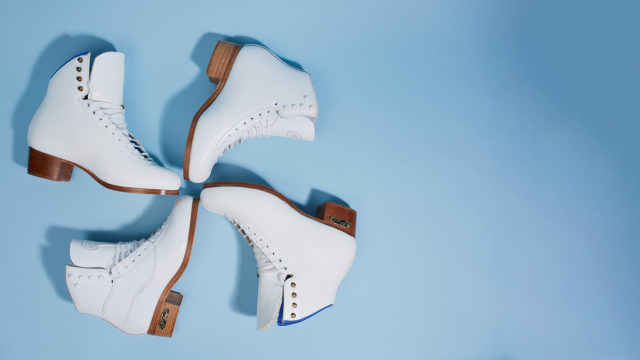

Frequently Asked Questions
How should a new ice skating boot fit?
The ball of the foot should lay flat and the toes pushed slightly together. A little wiggle room for the toes is acceptable. The width should not be so wide that you can curl your toes under or have to put two pairs of growth innersoles to take up the space.
The heel must be very snug. The best possible fit would be to have the heels locked in place and no up and down movement. As the boots break-in, the heel pocket may widen a little. Therefore, if the boots are fitted wide in the heel, they will feel sloppy or loose after break-in.
Because we realize that heel fit is often the most frustrating issue for skaters and skate shops, we developed the combination ball and heel sizing on stock boots. This allows the skater to be fitted in a more comfortable width for the ball and a tighter width in heel. The combination size stock boots are available in all the stock models and all size ranges.
How should I heat my ice skates?
What's the right way to break in new figure skating boots?
You may find that when the boots are new, you may have to re-lace the boots during the session to allow for lace stretching, leather stretching and foam tongue compression. The top hooks should be left unlaced until you feel you need more support for jumps. Lacing the top hooks at the beginning may cause shin splints, tendonitis and bursitis or may cause the heel of the boot to separate. In addition, if you lace the boot to the top and do not bend properly, the crease may not develop at the ankle, but down below the lower instep area.
When you try to break-in boots by walking in them, you do not get the crease in the right place. Walking in skates breaks them in for a walking gait, where the heel strikes, weight transfers to the ball, and then pushes off the first toe. This is not the same action as stroking. Walking in the skates will cause creasing to develop forward of the instep.
I find I am on the inside edge most of the time. What could be causing this problem?
In most cases, a skater has problems on an inside edge because of pronation. Eighty percent of the population pronates to some degree. Those that have minimal pronation may have edge problems that require more than just a blade position adjustment. The bulk of the pronators require heel wedges, custom insoles, vacuum molded insoles or orthotics.
Why would a skater need custom figure skating boots?
A skater might choose custom boots to allow for:
- Two different lengths or widths
- Added dance flexibility (with scallop cuts or the V-Cut Flex Notch, asymmetrical ankle pattern)
- Better toe pointing (with a low-cut back)
- Stress relief (ankle pad channeling)
- Additional color or material choices
- Orthotics
- Different ankle support on left and right boot
- Reinforcements (with power tab or lunge pads)
- Special sole and heel requirements for blade positioning
- Orthopedic design for missing toes, fused joints, bone break repaired with medical hardware
What are the differences between insoles and orthotics?
The SP-Teri custom insole is made to fit the SP-Teri toe and heel shape and SP-Teri lengths. The insole lifts the heel and tilts it to the outside and supports under the arch. It is three quarters length from the back of the heel to the metatarsal heads. The insole will usually have a vinyl top cover, but may be ordered with a leather or poron top cover instead. The insole does not require additional room in the boots or upsizing to allow space. Custom insoles can be ordered at any time.
Over-the-counter insoles, on the other hand, can be purchased at most drug stores and sports shops. They usually lift the arch and may tilt the heels. The insoles are typically made to fit a dress shoe or athletic shoe, and must be trimmed down to fit into skating boots. Also, the forefoot portion is thicker than the SP-Teri custom insole and takes up more room in the toe box than is normally allowed for a proper fit.
When a skater is being fitted for boots and an over-the-counter insole is used for fitting, the skater, in most cases, requires a half-size longer boot or a wider width boot. This upsizing for competitive skaters can be a problem when an accurate, snug fit is needed.
Orthotics are underfoot appliances purchased through a doctor, physical therapist or clinic with a doctor’s prescription. They are made in a lab by trained technicians who specialize in biomechanical corrections. The appliances are most accurate to the skater’s specific needs to correct for biomechanical problems or leg length discrepancy.
The orthotic is made either full length or ¾ length. Some ¾ length orthotics will have a top cover extending to the end of the toes. There are many different materials used to make orthotics. The best materials for skate orthotics are made of graphite, fiberglass or light plastic. These are lightweight and rigid.
When orthotics are used in skates, the device must lay neatly in the boots and without interference of the counter of the boots. If the boot does not have sufficient room for orthotics, it may tilt to the outside, slide forward, or rock up and down.
In most cases, an orthotic cannot be placed in a stock boot without sacrificing the accuracy of the arch and heel correction. The recommended accommodation for orthotics is to have custom boots made with an allowance for the orthotics. With this method, a cavity can be created in the custom boot to allow for the proper width, arch height and pitch of the orthotics. The skater gets the proper size length boot with the orthotic serving as the underfoot support.
SP-Teri must be supplied with the orthotic that is going to be used in the custom boots when the boots are being made in order to design the correct upper pattern and construct the foot last with the required space for the orthotics.
I often see the boot tongue twist to the outside. Why does this happen?
The tongue twisting to the outside is a common problem. The reason is that the boots are made symmetrical (the same on both sides) but the foot is not symmetrical. The inside ankle is larger than the outside ankle. It is also more forward toward the centerline of the foot than the outside ankle. The inside half of the foot comes up higher than the outside and takes up more volume in the boot than the inside does. In addition, the ankle mechanics causes the leg to go slightly to the inside when the leg is bent forward. Subsequently, when the leg bends forward, the inside ankle hits the edge of the tongue and pushes the tongue forward. The outside half of the instep area usually has a little space between the foot and the boot, thereby allowing the tongue to twist and fill the space.
The more a skater bends, the more the tongue will be pushed to the outside. In addition, pronation contributes to the tongue being pushed to the outside. Other contributing factors are boots that are fitted too wide, breakdown, high insteps and skaters legs that are slightly larger than the upper allows for.
SP-Teri addresses the problem with the plastic lace loop inserted in the tongue. This allows skaters to lace through the loop in the tongue, pull the tongue to the inside and secure it in the center position.
How long will skates last?
Not finding the answers you need?
If you do not see your question addressed on this page, feel free to contact us.

